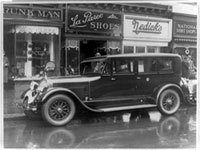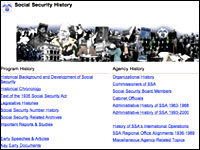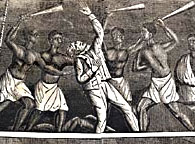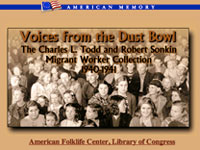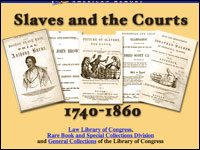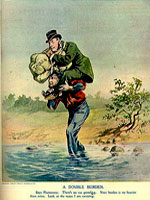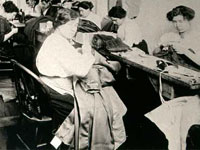A strategy that combines fiction and nonfiction texts to guide students in analyzing historical agency.
Authors of historical fiction for children and adolescents often anchor their narratives in powerful stories about individuals. Emphasis on single actors, however, can frustrate students’ attempts to understand how collective and institutional agency affects opportunities to change various historical conditions. History Book Sets (HBS) that focus on experiences of separation or segregation take advantage of the power of narratives of individual agency to motivate inquiry into how collective and institutional agency supported or constrained individuals’ power to act.
History Book Sets combine a central piece of historical fiction with related non-fiction. By framing a historical issue or controversy in a compelling narrative, historical fiction generates discussion regarding the courses of action open not only to book characters, but to real historical actors. Carefully chosen non-fictional narratives contextualize the possibilities and constraints for individual action by calling attention to collective and institutional conditions and actions.
- Select a piece of well-crafted historical fiction that focuses on a historical experience of separation or segregation (NCSS Notable Books is a good place to start). The example focuses on Cynthia Kadohata’s (2006) Weedflower—a story that contrasts a young Japanese-American internee’s relocation experience with a young Mohave Indian’s reservation experience.
- Select two pieces of related non-fiction that provide context for the historical fiction. Non-fiction should include courses of action taken by groups and institutions, as well as individuals. This example uses Joanne Oppenheim’s (2007) “Dear Miss Breed”: True Stories of the Japanese American Incarceration During World War II and a Librarian Who Made a Difference and Herman Viola’s (1990) After Columbus.
- Select photographs that visually locate the events in the literature. Duplicate two contrasting sets of photographs.
- Reproduce templates for poem (Template A) and recognizing agency chart (Template B). The recognizing agency chart works best if students begin with an 8½x11 chart and then transfer their work to larger chart paper.
- The time you need will depend on whether you assign the historical fiction for students to read or use it as a read-aloud. Reading a book aloud generates conversation, ensures that everyone has this experience in common, and lessens concerns about readability. If students read the book independently, plan on three class periods.
- Recognizing Changing Perspectives. In making sense of historical agency, it helps if students recognize that different people experience historical events differently. For instance, the main fictional characters in the example have quite distinct views of relocation camps. The packets of photographs help children interpret changing perspectives, and the biographical poem provides a literary structure for expressing their interpretations.
-
- Organize the students in pairs. Give half the pairs Packet A (Japanese Experiences); half Packet B (Indian Experiences). Students write captions for the pictures explaining how the experiences pictured influence characters’ view of the relocation camp.
- Drawing on their discussion and readings, each pair of students writes a biographical poem (see Template A) representing how their character’s ideas and attitudes change over the course of the story.
- Display captioned pictures and poems where students can refer to them during the next activity.
-
- Recognizing Agency: What Can be Done?
-
- Distribute Recognizing Agency chart (Template B). Work through the chart using a secondary character in the historical fiction as an example.
- Assign pairs of students to a fictional or historical participant. For example, students might investigate the fictional main character or a family member or friend or students could investigate a historical participant.
- Display charts. Discuss:
- Why do some people, groups and institutions seem to have more power than others?
- How can people work most effectively for change?
- Can you identify strategies used to alter other historical experiences of separation or segregation?
-
- Agency Today. After considering the kinds of agency expressed by people during the past, students might write an argument for or against contemporary issues that surround the topic. For instance in the example, students investigate efforts to restore the relocation camp.
- Book selection presents the most common pitfall in developing and using an HBS. Historical fiction presents a two-pronged challenge: If the narrative in the historical fiction does not hold up, good historical information can’t save it. On the other hand, a powerful narrative can convince students of the “rightness” of very bad history. Never use books you have not read! With that in mind:
-
- Make sure you check out reviews of historical fiction and non-fiction (i.e. Hornbook, Booklinks, Notable Books) or more topic-specific reviews such as those provided by Oyate, an organization interested in accurate portrayals of American Indian histories.
- Choose non-fiction emphasizing collective and institutional agency that contextualizes actions in the novel.
-
- Because students’ identification with literary characters can be quite powerful, use caution in identifying one historical group or another as “we.” Implying connections between historical actors and students positions students to react defensively rather than analytically. None of your students, for instance, placed people in relocation camps or on reservations, but referring to past actions by the U.S. government as something “we” did can confuse the issue. Students are not responsible for the past, but as its legatees they are responsible for understanding what happened well enough to engage in informed deliberation about the consequences of past actions.
- Historical Book Sets are designed to work against tendencies to overgeneralize about group behavior (i.e. assuming all European Americans supported internment). In response to overgeneralization, ask for (or point out if necessary) counter-examples from the book set. Occasional prompting encourages students to test their generalizations against available evidence and to think about within-group as well as between-group differences.
- Historical Agency: Internment and Reservation at Poston. Background for the teacher: Groups and individuals exercise power differently, depending on the social, cultural, economic, and political forces shaping the world in which they are acting. In the case of the internment and reservation systems, for example, the power of Japanese-Americans to resist internment was quite different from the power of the War Relocation Authority to enforce relocation. Or, consider that the options available to Japanese men were quite different from those available to women or to the Native American residents of the Poston reservation. Introducing the concept of historical agency—what action was possible given the historical moment—can be a powerful tool for making sense of past behaviors. Power is a familiar concept to students who, with relatively little prompting, understand not only that larger forces may limit or expand opportunities for action, but that individuals may not all respond in the same way to those opportunities. Beginning by recognizing different perspectives on an event prepares students to consider why people might take different action, and comparing responses to action prepares students to consider available options for expressing agency. This, in turn, reinforces an important historical understanding: nothing happens in a vacuum. By placing so much attention on individual agency (often some hero or heroine), history instruction too often ignores persistent patterns of collective and institutional agency. This is not to dismiss narratives of individual agency. This HBS begins with Sumiko’s and Frank’s story because individual agency captures students’ interest and engenders a level of care that motivates further investigation of the differential agency expressed by the individuals, groups, and institutions that framed Sumiko’s and Frank’s historical choices. * Agency refers to the power of individuals, groups, and institutions to resist, blunt, or alter historical conditions. Differential agency refers to differences in potential for and expression of power within and between individuals, groups, and institutions.

